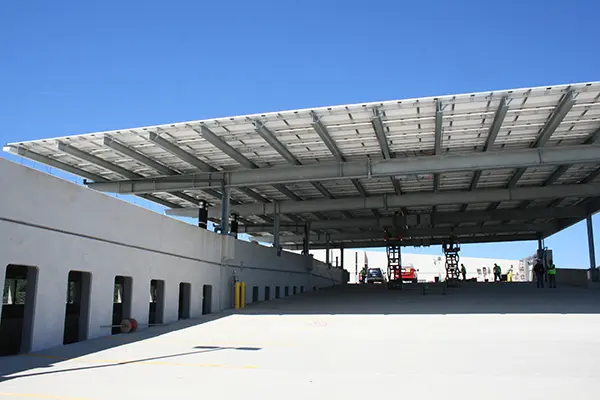University Reduces Electric Bill, and Carbon Footprint, with Installation of South Campus Array

09/01/2016
By Ed Brennen
The university is nearly doubling the amount of power it generates from the sun with the installation of a new solar panel array on the top floor of the South Campus parking garage, just one of several energy-saving projects completed over the summer as part of the state’s Accelerated Energy Program.
The 600-panel photovoltaic array sits atop a raised steel structure that is approximately 60 feet wide and 100 feet long, or about one-third the size of a football field. As a bonus, the new array provides cover for approximately 50 rooftop parking spaces that were previously exposed to the elements.
When the 200-kilowatt (kw) system is brought online in mid-September, it will be by far the most efficient of the five solar arrays on campus. The university’s four existing arrays, located on the roofs of Costello Gym, Bourgeois Hall, Leitch Hall and Dugan Hall, consist of 1,172 panels that are a combined 246 kw.
“The technology has really improved,” says Paul Piraino, energy and sustainability manager in the Office of Facilities Management and Planning, who estimates the latest system will generate 232,000 kilowatt hours (kwh) of electricity each year for buildings on South Campus.

This will not only reduce the university’s electric bill by $31,000 annually, but it will also reduce greenhouse gas emissions by 119 metric tons of carbon dioxide equivalent (MTCDe) — which is about how much 18 homes would generate each year through electricity produced by New England Grid power plants that run on coal, oil and other natural resources.
“The less power we rely on from the grid, the cleaner our carbon footprint,” says Piraino, who adds that the university is receiving $60,000 in annual solar renewable energy credits (SRECs) pegged for at least the next 10 years, which will help pay for half of the new $1.2 million system.
In addition to the solar panels, a second electric vehicle charging station was added to the second level of the South Campus garage this summer.
The Accelerated Energy Plan (AEP) is a three-year initiative that aims to cut energy costs among 700 selected sites across the state, including the university, by making them more energy efficient. Under the program, which is scheduled to be completed in November 2017, the state is investing $27 million to implement more than 100 energy-saving measures to 30 buildings across campus. Managed by the state’s Division of Capital Asset Management and Maintenance (DCAMM), the AEP will reduce the university’s energy costs by an estimated $1.26 million annually.
By conserving resources and reducing greenhouse gas emissions through measures like the AEP, the university is advancing on its pledge to achieve carbon neutrality by 2050, as laid out by the university’s Climate Action Plan.
Other AEP projects tackled across campus this summer include:

- The replacement of three 50-year-old steam boilers in the South Campus Power Plant with new models that Piraino estimates will improve efficiency by 8 percent to 10 percent. The new boilers will provide heat to all buildings on South Campus except the McGauvran Center (which has its own boiler) and reduce greenhouse gas emissions by 290 MTCDe, or the equivalent of taking 64 vehicles off the road each year.
- The installation of efficient lighting and controls in 12 buildings: Durgin, Fox, Alumni, Olsen, Falmouth, Cumnock, Dugan and Coburn halls, Costello Gym, the Tsongas Center and the Bellegarde Boathouse. Combined, these upgrades will reduce energy by 1.4 million kwh and greenhouse gas by 716 MTCDe, which is the same as reducing consumption of fuel oil by 69,636 gallons annually.
- Upgraded heating, ventilation and air conditioning (HVAC) systems in the Wannalancit Business Center and Pinanski Hall, as well as HVAC digital control systems for Donahue Hall and an HVAC update with “variable air volume boxes” at the O’Leary Library (which will improve efficiency by only heating or cooling the amount of air that is needed in the building).
 A contractor installs new energy-efficient lighting high above a racquetball court at the Campus Rec Center.
A contractor installs new energy-efficient lighting high above a racquetball court at the Campus Rec Center. - Water heater replacements in Fox Hall, the Campus Recreation Center, Tsongas and Donahue. This fall, meanwhile, a solar thermal domestic hot water system will be installed at the UMass Lowell Inn & Conference Center. The project will use solar radiation to preheat the hot water used throughout the ICC, including the student living spaces, kitchens and laundry rooms. It will reduce greenhouse gas emissions by 30,283 MTCDe, which is the equivalent of saving nearly 1,200 gallons of gasoline from being burned.
Project Manager Hector Valdes is quarterbacking the AEP for Facilities Management, working with contractor Constellation New Energy.



